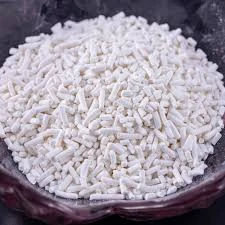
food stabilisers thickeners and gelling agents
Exploring Food Stabilisers, Thickeners, and Gelling Agents
Food stabilisers, thickeners, and gelling agents play a crucial role in the food industry, enhancing both the texture and appearance of food products. These substances are not just about improving mouthfeel; they also have functional roles that contribute to food preservation and stability during processing and storage.
Understanding Food Stabilisers
Food stabilisers help maintain the physical and chemical properties of food products over time. They work by preventing separation of ingredients, which is especially important in emulsions, such as salad dressings or sauces. Common stabilisers include gums, pectins, and certain proteins. For instance, xanthan gum, derived from the fermentation of sugar by the bacterium Xanthomonas campestris, is widely used due to its exceptional thickening power and ability to stabilize emulsions.
Stabilisers can also help maintain a uniform texture throughout the product’s shelf life. For dairy products, stabilisers are essential in preventing the precipitation of proteins and providing a smooth texture. In ice creams, stabilisers improve the creaminess by trapping air and reducing the formation of ice crystals, ensuring a pleasurable mouthfeel.
The Role of Thickeners
Thickeners are often confused with stabilisers, but they primarily serve to increase the viscosity of a liquid. They work by absorbing water and creating a thicker consistency, which can enhance the eating experience and help with moisture retention. They are vital in many culinary applications, from gravies and sauces to soups and desserts.
Common thickening agents include cornstarch, flour, and various gums. Cornstarch is versatile and is used in both hot and cold applications. When mixed with liquid and heated, it gelatinizes, creating a thickened texture. Guar gum, a natural thickener derived from guar beans, is often used in gluten-free products to provide structure and texture that gluten would typically deliver.
Gelling Agents Creating Structure
food stabilisers thickeners and gelling agents

Gelling agents have the ability to transition from a liquid to a gel state, forming a stable structure that can hold its shape. They are pivotal in products like jellies, jams, and gummy candies. The most common gelling agent is gelatin, which is derived from animal collagen. It’s widely used for its ability to create a clear, elastic gel that melts in the mouth.
For vegetarian and vegan applications, alternatives like agar-agar and pectin are popular. Agar-agar, sourced from red algae, sets more firmly than gelatin and is frequently used in Asian desserts. Pectin, a plant-based polysaccharide found in fruits, is particularly important for making jams and jellies; it requires sugar and acid to create a gel, making it ideal for preserving the freshness of fruits.
The Importance of These Agents in Food Processing
In processed foods, stabilisers, thickeners, and gelling agents contribute significantly to product reliability. They improve the shelf life of products by preventing phase separation and maintaining consistency, thus ensuring the safety and quality of food. With the increase in consumer demand for convenient, ready-to-eat options, these ingredients allow manufacturers to deliver products that remain attractive and palatable over time.
Health Considerations and Consumer Trends
While these food additives are generally recognized as safe, consumer awareness about health and wellness has prompted a rise in demand for natural and clean-label products. As a result, food manufacturers are increasingly exploring plant-based and organic alternatives to traditional stabilisers and thickeners. Ingrediants such as guar gum, carrageenan, and locust bean gum are being embraced not just for their functional properties but also for their natural origins.
Despite the abundance of options, food scientists are tasked with ensuring that these ingredients perform effectively while meeting the evolving health preferences of consumers. The balance between functionality, consumer safety, and taste will continue to shape the future of food stabilisers, thickeners, and gelling agents.
Conclusion
In summary, food stabilisers, thickeners, and gelling agents are indispensable components in the food industry, enhancing texture, stability, and overall enjoyment of food products. As trends in health and nutrition evolve, the demand for innovative, natural alternatives will shape the landscape of food formulation, ensuring that these agents continue to play a key role in food technology for years to come.
-
Understanding Synthetic Rubber OptionsNewsApr.27,2025
-
Trichloroisocyanuric Acid: Essential for Clean and Safe WaterNewsApr.27,2025
-
Sodium Dichloroisocyanurate: Key to Safe Water TreatmentNewsApr.27,2025
-
Sodium Acid Pyrophosphate: Essential in Modern Food ProcessingNewsApr.27,2025
-
Essential Water Treatment ChemicalsNewsApr.27,2025
-
Denatured Alcohol and Its Industrial UsesNewsApr.27,2025
-
The Versatile Uses of Sodium BicarbonateNewsApr.24,2025
Hebei Tenger Chemical Technology Co., Ltd. focuses on the chemical industry and is committed to the export service of chemical raw materials.
-

view more DiethanolisopropanolamineIn the ever-growing field of chemical solutions, diethanolisopropanolamine (DEIPA) stands out as a versatile and important compound. Due to its unique chemical structure and properties, DEIPA is of interest to various industries including construction, personal care, and agriculture. -

view more TriisopropanolamineTriisopropanolamine (TIPA) alkanol amine substance, is a kind of alcohol amine compound with amino and alcohol hydroxyl, and because of its molecules contains both amino and hydroxyl. -

view more Tetramethyl Thiuram DisulfideTetramethyl thiuram disulfide, also known as TMTD, is a white to light-yellow powder with a distinct sulfur-like odor. It is soluble in organic solvents such as benzene, acetone, and ethyl acetate, making it highly versatile for use in different formulations. TMTD is known for its excellent vulcanization acceleration properties, which makes it a key ingredient in the production of rubber products. Additionally, it acts as an effective fungicide and bactericide, making it valuable in agricultural applications. Its high purity and stability ensure consistent performance, making it a preferred choice for manufacturers across various industries.











